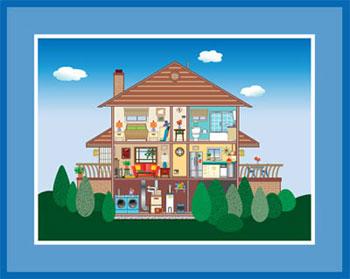Benefits and Features of Indoor airPLUS Homes
Homebuyers today are increasingly concerned about the indoor air quality of their homes. Issues like mold, radon, carbon monoxide and toxic chemicals have received greater attention than ever as poor indoor air quality has been linked to a host of health problems. With ENERGY STAR and Indoor airPLUS, builders can employ a variety of construction practices and technologies in their new homes to help address these concerns.
Homes displaying the ENERGY STAR Certified Home and Indoor airPLUS labels provide unparalleled energy efficiency, comfort, durability, indoor air quality, and peace of mind.
On this page:
Benefits of Indoor airPLUS Homes
Healthier Homes by Design
Indoor airPLUS qualified homes have numerous advantages.
Improve Indoor Air Quality
Indoor airPLUS is a companion label to ENERGY STAR. Together, these programs provide comprehensive health protections. Homes built to earn the Indoor airPLUS label include features to reduce contaminants that can lead to poor indoor air quality, including mold, moisture, radon, carbon monoxide, toxic chemicals and more.
Minimize Pollutants
Moisture and pest control, among other things, can help protect your family by eliminating common allergens from entering the home, such as mold and pest residue. Your builder will provide a first line of defense against pests like cockroaches and rodents by fully sealing, caulking, or screening where pests enter your home.
Improve Comfort
Your ENERGY STAR and Indoor airPLUS home can provide a more comfortable living environment because it includes properly engineered HVAC system sizing, improved duct and equipment installation, improved filtration and whole-house and spot ventilation to dilute and remove indoor pollutants.
Protect Against Combustion Pollutants
The home provides protection from potential exposure to combustion pollutants by the installation of heating equipment that cannot spill combustion gases inside the home and preventing pollutants in the garage from entering your house. Also, carbon monoxide alarms are in all sleeping areas.
Home Maintenance Manual
After purchasing a home with EPA Indoor airPLUS qualification, you'll receive a manual explaining your home's indoor air quality features and how to operate your home to continue minimizing the risk of indoor air quality problems. In addition, your home will have a label as proof that it was built to the high indoor air quality specifications if you resell the home.
Energy Efficiency
All Indoor airPLUS homes must first earn ENERGY STAR certification. ENERGY STAR certified new homes are designed and built to standards well above most other homes on the market today, delivering energy efficiency savings of up to 30 percent when compared to typical new homes. A new home that has earned the ENERGY STAR label has undergone a process of inspections, testing and verification to meet strict requirements set by the U.S. Environmental Protection Agency (EPA), delivering better quality, better comfort and better durability.
- Learn more about ENERGY STAR certified new homes.
Indoor airPLUS Design and Construction Features
- Moisture Control
Moisture leads to mold and other biological pollutants that can cause health problems.
- With ENERGY STAR and Indoor airPLUS, builders use a variety of moisture control features designed to minimize these risks, including improved control of condensation and better roof, wall and foundation drainage.
- Radon Control
Radon is a naturally occurring radioactive, invisible, and odorless gas and is the second leading cause of lung cancer in the United States.
- Indoor airPLUS specifications include radon-resistant construction techniques (in areas with high radon potential).
- Pest Management
Residue from pests, such as rodents and cockroaches, can trigger allergy and asthma attacks.
- With ENERGY STAR and Indoor airPLUS, builders seal, caulk or screen where pests may enter a home.
- Heating, Ventilating and Air-Conditioning (HVAC)
Poorly designed and installed HVAC systems can lead to comfort problems and reduce indoor air quality.
- ENERGY STAR with Indoor airPLUS includes properly engineered systems, improved duct and equipment installation, improved filtration, and whole-house and spot ventilation to dilute and remove indoor air pollutants. Builders also inspect air-handling equipment and ductwork to ensure they are clean and free of debris and provide adequate air flow.
- Combustion Venting
Poorly vented heating equipment can cause combustion gases to accumulate inside the home.
- ENERGY STAR with Indoor airPLUS can help protect you from exposure to combustion pollutants by using properly vented heating equipment, installing carbon monoxide alarms in all sleeping areas, and taking steps to stop garage pollutants from entering your home.
- Building Materials
The types of materials that builders choose and the way they manage them during construction can improve a home’s indoor air quality.
- Indoor airPLUS Specifications reduce the sources of pollutants inside the home by protecting materials stored on-site from weather damage, using materials with less chemicals, and ventilating the home prior to move-in.

